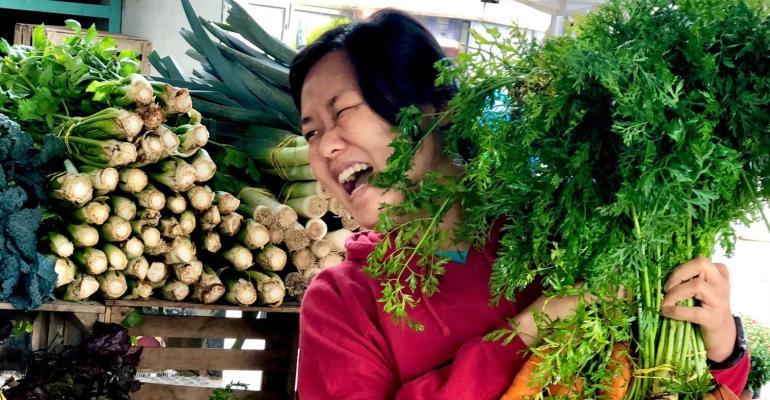Ji Hye Kim has always been committed to celebrating the diversity of the food of her native South Korea. The menu at her Ann Arbor, Mich., restaurant Miss Kim uses her passion for Korean culinary traditions and melds it seamlessly with the finest in Michigan produce, working closely with local farmers. Recently, a trip home to South Korea included doing some deep dives into regional foodways, and she even spent some time with famed monk Jeong Kwan, whose Temple Cuisine was profiled on Netflix’s Chef Table. Those travels are impacting her current menus at Miss Kim in exciting ways. Kim recently discussed her new menu innovations.
What is Temple Cuisine?
Korean temple cuisine is the traditional food cooked and consumed at Buddhist temples. Often it is known to be vegan, but in its root, it is not dogmatically so, and it is bigger than just being vegan. The point is to prevent unnecessary loss of life just to provide food; it is not to avoid meat. Korean Buddhist cuisine is about the practice of Buddhism through food, with appreciation of life. Here are the tenets of Korean Buddhist cuisine: Avoidance of meat, avoidance of alliums, adherence to local and seasonal ingredients, reduction of waste, being in harmony with nature.
What is the reasoning behind exploring this style of cooking at Miss Kim?
I was, and still am, doing a lot of research into Korean culinary traditions. I love farmer’s markets and want to celebrate vegetables at Miss Kim, though we are not a vegetarian restaurant. Exploring Korean Buddhist temple food was just a natural next step.
Another point of interest was that even though the Korean Buddhist cuisine does not use alliums [such as onion and garlic], it uses other spices more prominently than your average Korean dishes, especially the use of Sichuan or sansho peppercorns. I found that very interesting and wanted to see how spices work more with Korean food.
What sort of research or experiences went into celebrating this aspect of Korean foodways?
I am lucky enough to be very fluent in Korean, even after over three decades in the U.S., so lots of reading for sure. And eating! Whenever I go to Korea, I visit Buddhist restaurants and temples, have conversations with the Buddhist nuns, walk around temples and their vegetable gardens, and then experience Buddhist dishes made with those vegetables. This all really makes you realize it’s more than avoiding meat.
Tell us about some of the specific menu items and how they came about, how are you innovating within the construct of temple food?
Bibimbap from Buddhist temples is famously delicious. I grew up Christian, never having set my foot inside a Buddhist temple, and even as a child I’ve heard about it. It makes total sense, right? Bibimbap is full of beautiful vegetables, and Buddhist cuisine really takes it to the next level by using vegetables and fermented sauces produced from the temple. We offer Buddhist bibimbap during summer when the vegetables are super abundant in Michigan. It consists of local vegetables, and we keep the flavors simple and clean so you can really taste how great local vegetables in season can be.
Another example is seasonal vegetables lightly battered and fried. We have that dish on the menu all year-round, but we change up the vegetables seasonally. Cauliflower for winter, green beans for the summer, green tomatoes for late summer, delicata squash for the fall. Some of these vegetables are not native to Korea, but they are local and beautiful when in season in Michigan.
I don’t see this as innovation of the temple food, but rather adaptation or another iteration. I adhere to the tenets of Buddhist cuisine within the context of Michigan and our guests at the restaurant, but without turning it into obsession. That is also the way of Korean Buddhism — to practice as best as you can, but without turning it into a big attachment or obsession.
How do these dishes flow within your broader menu?
They flow really well. Two major inspirations at my restaurant are Korean traditions and Michigan farmers. Incorporating Buddhist temple food works perfectly with it. And some of these dishes like fried seasonal vegetables [twigim in Korean] are our perennial best sellers that every table orders, not just vegetarian guests. You don’t have to be a vegan to enjoy them because they’re delicious.





